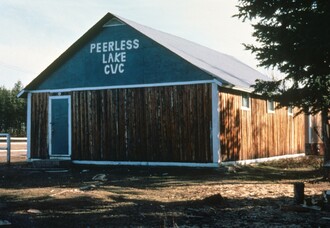History

Original Peerless Lake Campus
On August 25, 1999, Northern Lakes College launched under its new name. However, we can trace our history back to 1970-71 when Education Technicians were trained at the Alberta Vocational Centre (AVC) in Grouard. Education Technicians were indigenous students who were prepared to provide instruction in adult basic education in the Community Vocational Centres (CVC) service area. The Grouard Campus also had an upgrading program along with several vocational programs.
By 1974, twenty-six CVCs dotted the northern part of Alberta. Each CVC had an education committee elected by the community. In later years, the committees were nominated from among the elected bodies that represented the communities. Each committee's role included setting priorities for programming, recruitment and selection of students, and selection of staff serving the campus. In the early phases of development, the education committees met periodically to deal with regional and joint issues. This method of meeting was modified. By 1980, the communities sent a voting representative to a council which met once per month to deal with regional issues. AVC Grouard ran a number of Education Technician programs until the need for instructors diminished. However, AVC Grouard expanded its program offerings and included two satellite campuses.
While AVC Grouard and the CVCs were "sister" institutions, they operated separately as individual provincially-administered institutions until they were amalgamated in 1988. The amalgamated institution became known as Alberta Vocational Centre - Lesser Slave Lake, and soon after as Alberta Vocational College - Lesser Slave Lake. With amalgamation, the Minister responsible for post-secondary education assured each community that had a campus that education committees would continue. The College's main offices were located in Grouard and Slave Lake. AVC - Lesser Slave Lake negotiated a mandate statement with the Department. It also signed an agreement with two other public colleges in northern Alberta to cooperate in the offering of programs to northern learners.
AVC - Lesser Slave Lake inherited a leading edge project begun by AVC Grouard related to distance education. The efforts were enhanced and expanded to the point that courses could be delivered by teleconferencing, audio-graphics conferencing or video conferencing. Learners in all the communities in the College's service area enjoyed access to courses and programs from their home communities. They were linked to the learning opportunities offered by this college and also the distance delivery provided by other institutions.
In 1996, the College celebrated its 25 anniversary. A Governance Task Force review from 1995 eventually led to the recommendation that this Provincially-Administered Institution be transitioned into a Public Board-Governed College. On September 1, 1997 board governance took effect under the guidance of an Interim Governing Authority (IGA). The IGA remained in place until the 11 member Board was established in April 1998.
Currently, the College serves a region of 164,000 square kilometers, and more than 50 communities including fifteen First Nations and four Métis Settlements.
Community Education Committees and their Council remain an integral part of the College. Flexible programming and customized training has provided opportunities for the College to deliver programs outside of our service region. Partnerships established with local First Nations and Métis Settlements, business and industry, and other educational institutions continue to flourish and allow the College to forge ahead with new ideas. Providing the right training to meet an individual's needs at an affordable price remains critical to our success.